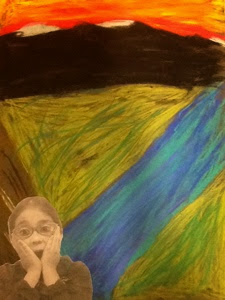I am constantly encouraging students to "draw what you see, not what you know." This lesson was an exercise in drawing from observation. We got up close with our pinecones and looked for patterns and repeating shapes. We tried to capture interesting views of the pinecones as we made the smallest details the focal points of our drawings. Third and fourth graders worked carefully in pencil and Sharpie marker before painting their works using value scales with liquid watercolors.
This is the art blog for Fayston Elementary School, located in the Mad River Valley in Central Vermont. This blog is updated frequently to showcase the artwork of Fayston's students and celebrate all things creative!
Monday, December 8, 2014
Wednesday, December 3, 2014
Mondrian Squares in Primary Colors
Dutch artist Piet Mondrian was well known for his artwork made up of straight black lines and primary colors. He created grids using vertical and horizontal lines.
"I construct lines and color combinations on a flat surface, in order to express general beauty with the utmost awareness. Nature (or, that which I see) inspires me, puts me, as with any painter, in an emotional state so that an urge comes about to make something, but I want to come as close as possible to the truth and abstract everything from that, until I reach the foundation (still just an external foundation!) of things…
I believe it is possible that, through horizontal and vertical lines constructed with awareness, but not with calculation, led by high intuition, and brought to harmony and rhythm, these basic forms of beauty, supplemented if necessary by other direct lines or curves, can become a work of art, as strong as it is true." - Piet Mondrian, (Netherlands, 1872-1944)
First and second grade artists were inspired by Mondrian's artwork. We used black paper strips to create the grids, then painted the rectangles and squares with the primary colors.
Labels:
collage,
First and second grade,
line,
Piet Mondrian,
primary colors
Monday, November 24, 2014
Inspired by Edvard Munch's painting "The Scream"
The Scream (Norwegian: Skrik) is the popular name given to each of four versions of a composition, created as both paintings and pastels, by the Expressionist artist Edvard Munch between 1893 and 1910. Der Schrei der Natur (The Scream of Nature) is the title Munch gave to these works, all of which show a figure with an agonized expression against a landscape with a tumultuous orange sky. Arthur Lubow has described The Scream as "an icon of modern art, a Mona Lisa for our time."[1]
Edvard Munch created the four versions in various media. The National Gallery, Oslo, holds one of two painted versions (1893, shown here). The Munch Museum holds the other painted version (1910, see gallery, below) and a pastel version from 1893. These three versions have not traveled for years.[2]
The fourth version (pastel, 1895) was sold for $119,922,600 at Sotheby's Impressionist and Modern Art auction on 2 May 2012 to financier Leon Black,[3][4] the second highest nominal price paid for a painting at auction.[5] The painting was on display in the Museum of Modern Art in New York from October 2012 to April 2013.
Also in 1895, Munch created a lithograph stone of the image. Of the lithograph prints produced by Munch, several examples survive.[6] Only approximately four dozen prints were made before the original stone was resurfaced by the printer in Munch's absence.[7]
The Scream has been the target of several high-profile art thefts. In 1994, the version in the National Gallery was stolen. It was recovered several months later. In 2004, both The Scream and Madonna were stolen from the Munch Museum, and were both recovered two years later.
from wikipedia.com



Subscribe to:
Comments (Atom)
























































